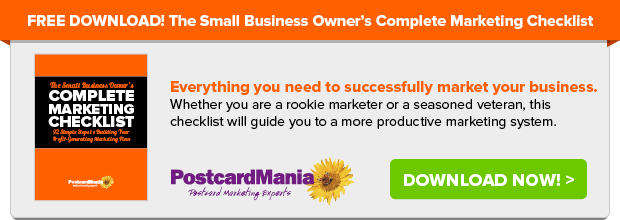4 Things Harvard Researchers Say You Should Do in a Down Economy (and 2 to AVOID at All Costs)
Updated on July 15, 2021This week we’ve heard news that some businesses in select states are going to be reopening.
This sounds promising, and I’m hoping it continues where appropriate and we can all start getting back to work, being productive and contributing to a much-needed economic recovery.
As much as I want to believe that we can flip the pandemic switch and everything will return to “business as usual,” the truth is:
There will be a recovery period.
The good news is:
Your recovery can start NOW.
There are specific things you can do before you reopen to ensure that your business really hits the ground running and bounces back even stronger once this dark pandemic cloud finally dissipates.
And since I love stats and research, I found a research study from Harvard Business School that tells us exactly how to do it.
Obviously as the CEO of a marketing company, it’s WAY too easy for me to say “make sure you continue marketing your business,” but I’m not even going to go there because I know you’re struggling and that kind of advice can come across as completely self-serving.
Just remember:
I’m a business owner like you.
I started PostcardMania from scratch in 1998, growing it from a tiny startup into a company with over 279 staff. I did this without funding and without accepting any capital investments.
I also survived the Great Recession (circa 2008) by the skin of my teeth, so I’ve been here before.
But:
When I sat down to strategize how I can help small businesses get through this, I knew I needed to bring more to the table than just my own story.
I needed cold, hard facts.
I also wanted to know:
Is there actual data, culled from other businesses, to tell us exactly what we should be doing during a recession or down economy?
Something other than anecdotes and advice from advertisers and marketers.
Luckily, yes, and —
The data is supplied by Harvard researchers.
(Yes, I know that Harvard has caught a lot of flak lately for receiving $8.6 million in federal aid as a result of the CARES Act — despite having the largest academic endowment in the world, worth more than $40 billion. This study was written well before the CARES Act was even passed.)
Like a lot of business owners out there, they were tired of hearing the same old “recession marketing advice” from marketers and ad people.
So, they set out to find facts to answer an all-important question:
What is the best path forward for a business during and after a tough economy?
To answer that question, Harvard researchers embarked on a year-long project to analyze what different companies did during three global recessions, namely the major slowdowns that took place during these years:
- From 1980 to 1982
- 1990 to 1991
- 2000 to 2002.
Note: this project commenced before the 2008/2009 recession, hence why that slump isn’t included.
I was interested in this research, because as a marketer, I know that you should continue marketing during a downturn.
I learned this lesson the HARD way, but I also wanted to see how other companies survived major recessions, and what they did in addition to — or in lieu of — marketing.
The Harvard study worked like this:
- Harvard researchers studied 4,700 public companies
- They analyzed their key financial metrics from 3 years before, during, and 3 years after the aforementioned recessions
- They cataloged the findings, boiling down the numbers into strategies we can use.
Out of the gate, here were the statistics:
- 17% of the analyzed companies didn’t survive the recession (closed, went bankrupt, etc.)
- 80% failed to regain their pre-recession growth rates (sales and profits) 3 years after the recession
- Only 9% GREW after the slowdowns, with better numbers after than before
- Those same 9% outgrew their competitors by 10% in sales and profit growth post-recession
Let me say that again:
Only 9% of the companies analyzed actually fared better after the recession than before.
That means:
Only 423 companies effectively managed an economic slowdown — while 4,277 companies mismanaged the recessions and shrunk.
Before I share from the Harvard study what that 9% did, it’s important to know what NOT to do, so you don’t suffer devastating, insurmountable losses like 17% of those businesses did.
So, if you’re thinking about SLASHING COSTS right now (and who isn’t?), keep reading.
Here are the pitfalls from the study to avoid:
- Avoid reactionary cost-cutting, like layoffs
- Don’t invest blindly (more on that below)
Businesses that cut costs faster and deeper than their rivals fared poorly overall. They have the lowest probability — 21% — of pulling ahead of the competition when times get better, according to the study.
I’m not saying you shouldn’t tighten finances right now.
You should, of course. You know your business better than me.
But what you cut — and where you dedicate your resources — can mean the difference between surviving this recession and losing your foothold in the marketplace.
So, that begs the question:
What SHOULD you be doing? What’s the blueprint, according to Harvard?
Well, there are 4 things you should do to put yourself and your business in the best position possible to survive the current downturn.
Let’s get to it.
1. DO NOT respond too aggressively OR defensively when times get tough
Like I mentioned, Harvard researchers analyzed 4,700 companies and how they reacted to recession-like circumstances.
So, which companies fared the best? The researchers said it best:
“According to our research, companies that master the delicate balance between cutting costs to survive today and investing to grow tomorrow do well after a recession. Within this group, a subset that deploys a specific combination of defensive and offensive moves has the highest probability—37%—of breaking away from the pack. These companies reduce costs selectively by focusing more on operational efficiency than their rivals do, even as they invest relatively comprehensively in the future by spending on marketing, R&D, and new assets.”
We have our own examples of how we’re applying this right now within PostcardMania — mainly in our digital and SEO department expansions — and by refusing to cut any marketing outflow. More on that in a moment though.
So, essentially:
The ideal scenario is finding the right balance between being defensive and aggressive during these economic downturns.
And of course, you can also be TOO defensive and TOO aggressive — neither of which is ideal.
One example is Hewlett-Packard (HP). At the height of the 2000 recession, HP’s then-CEO Carly Fiorina (remember her from the Republican primaries in 2015??) said this:
“In blackjack, you double down when you have an increasing probability of winning. We’re going to double down.”
HP definitely doubled down in 2000. They splashed piles of money around in every which way — they bought the company Compaq, they increased R&D, they completely rebranded AND they invested heavily in expanding into new markets.
By 2004, HP’s EBITDA earnings (8.4%) fell behind IBM’s (16.8%) and Dell’s (9.3%). They were stretched too thin, and so were their customers!
Of course, you can also be too defensive.
In the 2000 slowdown, Sony cut everything — they cut their workforce by 11%, their R&D by 12% and their capital expenditures by 23%. This may have helped their profit margins when times were tough, but once the economy picked up speed again, they were left holding the bag.
In the years before the 2000 slowdown, Sony’s sales had been growing by an average of 11%.
In the years after the slowdown — and after their cuts — sales growth shrunk to 1%.
Now, it’s easy to say…
“Oh yeah, find the right balance and you’ll be okay.”
But we all know it isn’t that easy!!
So, there are a few things we can do to strengthen our businesses now for tomorrow’s economic upturn…
2. Improve efficiency instead of making cutbacks for a 1,000% better return
The Harvard study showed that cutting your workforce during an economic downturn translated to a small probability — just 11% — of getting ahead after the recession.
Further:
Cutting your workforce did not translate into better post-recession profits.
The study showed that post-recession profits rose $600 million on average for the businesses that were overly defensive-minded.
However:
Businesses that focused on efficiency over making cuts?
Their sales increased by an average of $6.6 billion — an improvement of 1,000%.
What does this mean?
Rather than cutting back to save capital right now, focus on creating new efficiencies that can either save money, or even generate new reach for your business’s services, whether now or in the future.
We haven’t cut anyone at PostcardMania, but have made it possible for 200 of our staff to work from home.
Efficiency-wise, we’ve invested in software systems to streamline and organize the following:
- Leads, including where those leads came in
- Campaigns (all the details and designs of postcard campaigns)
- Orders (products/services ordered, and financials)
We originally invested in this software in 2017 but continue to augment it in order to save money in our operations.
Regardless of where your business is right now, there is some area that can be made more efficient, likely with the inexpensive addition of some type of technology.
Here are some examples (both quarantine-friendly):
Automate seasonal messaging
Use a free or inexpensive email marketing program (like MailChimp, or example) to program emails ahead of time to be disbursed on certain dates at specific times.
If you’re a pool business owner, you can program emails to send out in the fall to your current customers reminding them to call you to prepare their pools for the winter season.
If email marketing leaves your mystified, you can download this for help:
FREE report: Set up automated email marketing to generate more leads
Next, you can join the ranks of technology giants and implement this:
Send programmatic direct mail easily, and for cheap.
Programmatic direct mail is direct mail that responds a trigger, like someone fills out a form on your website or buys something from you for the first time.
Now, you can send out one-off postcard reminders to customers and lead-nurturing messages to prospects, directly from your database or CRM —
100% automatically.
Plus:
You only pay for postcards that are automatically triggered to print and mail by specific criteria you set, mailing as few as 1 postcard per week (but still benefiting from bulk postage and print rates!). My company offers this service online, which you can learn more about at postcardmania.com/zapier.
Direct mail is still as relevant as ever, particularly because the response rate for direct mail is 900% better than email when contacting your own customers —
And 490% better when contacting new prospects.
3. Invest in strategies and assets that can bring in new business for a 40% growth in sales
According to Harvard researchers, companies that continued to tailor their services to customer needs during a recession fared FAR better in the years following the slowdown than companies that didn’t change, but merely continued with the same pre-recession strategies.
An example from the study:
Target increased capital expenditures by 50% in 2000 and focused on expanding into markets (such as grocery with Super Target stores) and increasing its internet-based business.
As a result, sales grew by 40% and profits grew by 50% over the course of a recession, and their profit margin even increased 1% in the years following the down economy.
However, another example…
TJX Companies (known for TJ Maxx and Marshall’s) increased capital expenditures by nearly 100%, all of which focused on expanding retail space due by buying up cheap real estate.
Although TJX enjoyed increased sales in the midst of a down economy, it didn’t improve their bottom line.
In fact:
Bottom line growth was 9% lower in the years after a recession.
None of us are Target or TJ Maxx, so what’s the takeaway here?
Basically: look forward.
I recommend offering your services virtually where possible.
Don’t stop communicating with your customer base. Your customers still need you, they still want to know that you’ll be around after this is over — but they likely need a virtual option for the time being to connect with you.
For example:
If you’re a mover, do a Facetime video walk-through to get a quote.
If you’re a dentist, you can offer tele-dentistry to get face-to-face with patients rather than having them put off dental care entirely. You can listen to patient concerns, determine if an ailment is an emergency, or even offer a brand new second opinion tele-dental service that won’t cost you much more than a bit of time.
If you’re a plumber, handyman, or other home service technician, use video on your smartphone to diagnose the problem before any of your staff enter homes.
Find ways to provide one-on-one service virtually now and in the future.
These quarantines have everybody learning online video softwares so if you can meet customers virtually, you could be way ahead of competitors who won’t take the time to learn Zoom or Facetime or the like.
Further (and this may seem obvious), but if you have products you can sell online, now’s the time to do it.
Been holding off on redoing your website? Take a look at that now.
Website design can be done VERY affordably right now.
Add a shopping cart to your website if possible and continue selling items that people would usually have to purchase in person.
A simple eblast out to your customer list can generate product sales day and night, and don’t forget the power of social media.
We are taking this time to invest in R&D and expand into a new area that we’ve heard clients asking for — for literally years.
We’re working full speed ahead right now on our SEO service, which was one of the big 2020 launches we planned at the beginning of the year. We’ve taken this opportunity to research this area within an inch of our lives so that we price it fairly and competitively, and offer a superior product for the price.
We also hired an SEO genius to manage the team as this is something so many of clients have asked us to do. We have soft-launched with a few really great clients that have been with us for years!
4. Find new business opportunities by discovering what your customers need right now
For the time being, this pandemic has changed businesses, but what you may not see is that not all industries have been shut down, and thus:
There may be expansion possibilities for you which could bear much fruit when quarantines end.
For example:
Recently I sold one of the buildings on PostcardMania’s campus and will be working to add space to our main building area to accommodate more digital presses.
In talking to a construction team, I found out that there are over 100 commercial construction projects still going on in the Tampa Bay area.
In other words:
Companies are still expanding, which is exactly what the Harvard study suggests you do.
Businesses that survive recessions and flourish afterward invest in:
- Research of what their customers/prospects need
- Development of relevant solutions for now
- Development of new solutions for future
- And marketing above their competition
What we’re doing is continuing our technology investments to make online postcard ordering easy for low quantity and programmatic orders.
Our new space, and additional digital presses, will make ordering personalized postcards and triggered direct mail easier and more abundant for our clients, who will need our help both now and of course, in the future.
Don’t stop communicating with your customers and prospects.
Reach out by email, social media ads, and direct mail to let them know you are still operational (however you are), and find out what they need so you can innovate (even cheaply!) to supply solutions that could make your business dwarf your competition.
To help with this, we’re offering something special:
“We’re Back Open” postcard campaigns for up to 20% off.
You can prepare your business now for reopening. Once you place your order and print your cards, we will hold them for you.
Then, when you’re ready to open, just give us a call and we’ll mail your cards immediately and you’ll be able to reach people where they are now — at home.
I love this campaign so much because it is so vital and so needed right now. You HAVE to let your customers know that you’re open again for business!
Another idea:
Consider offering extra incentives for referrals during this time.
People know that small businesses got hit hard by the shutdowns, so promote supporting America’s backbone by incentivizing referrals or purchasing gift cards for later use.
It’s totally okay to elicit help during this time — everyone’s coping.
And don’t be afraid to market your business however you can.
It’s the ONLY way your customers and prospects will know you’re still open as sadly some of your competitors may have gone down in this pandemic.
Plus, restrictions on quarantines will lift at some point, so you want to be ready and top of mind for your prospects who’ll need dentists, landscapers, hairstylists, and the much needed night out at a local restaurant.
If we can assist you at all during this time, we’re still offering our free one-on-one consultations to help at 800-628-1804.
Or you can email me directly at joy.gendusa@postcardmania.com
Wishing you well,
Joy
P.S. Our Coronavirus Support Guide For Small Businesses is being updated daily so you can find out the latest financial assistance available to you, in addition to other health and economic news related to COVID-19.

2 Comments
Thanks for reading, Serina!






Love this article Joy!